Growing and smoking weed is a recreational activity that many people enjoy. However, it can be expensive to buy marijuana from the dispensary every time you want to get high.
Fortunately, there is an alternative – growing your own!
Growing your own cannabis plants will allow you to save money on buying weed by growing it at home instead of purchasing it at the local dispensary. You’ll also have more control over what goes into producing your buds, as well.
If you’re interested in how to germinate marijuana seeds, then this blog post has all of the information you need! Keep reading to learn how to take a few seeds and turn them into a full-blown cannabis plant grow operation!
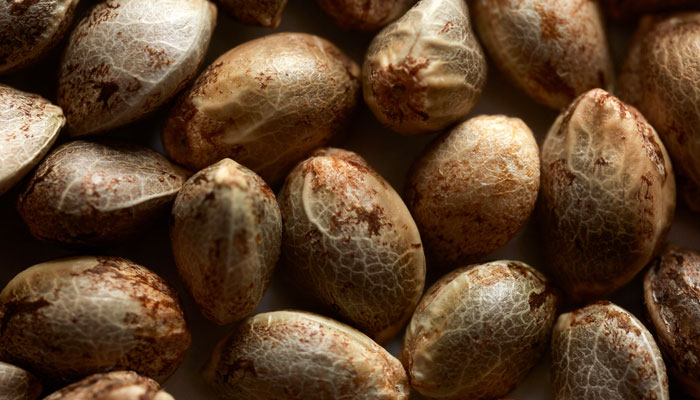
Selecting the Right Cannabis Seed
For the best results, you’ll want to germinate seeds you can afford. Start with the best seed you can afford to buy online or get from friends.
You’ll need to choose between Indica, Sativa, and hybrid based on your preferences for drug effects or market demand.
The most important consideration here is to ensure you buy feminized seeds. Feminized seeds will produce female plants. Since males are virtually worthless, this has the potential to save you valuable time and resources by ensuring you grow bud-bearing plants.
Most of the time, if you’re planning to germinate seeds you found in your bud, you’ll likely have 60% female plants and a 40% chance of growing a male cannabis plant with each plant. The time it takes to germinate seeds is better spent on a few seeds you know will turn out to be females.
You can also choose among several varieties including many varieties of marijuana as it is just the right size of the cannabis strain you require. Cannabis cultivars starting with feminized seeds germinate female plants that eventually produce buds as they mature.
Different Types of Cannabis Seeds
When it comes to finding cannabis seeds to grow into a young plant and mature, there are many options available. It might be difficult to determine which strain is best for you when you’re looking to buy cannabis seeds. But consider the characteristics of the strains you’re thinking about growing and the growing conditions they demand and you’ll find the best option for you.
You must first decide whether you want regular seeds, feminized seeds, or autoflower seeds before deciding what variety to purchase. Let’s examine the differences between each of these options.

Regular Cannabis Seeds
We already know that cannabis plants are either female (bud bearing) or male (pollen-producing). They can also be hermaphrodites. But when you buy or acquire regular cannabis seeds, you’re getting a combination of all of these options, which means you’re likely to have male and hermaphrodite plants to pick out after you germinate your seeds and allow them to mature a bit.
Although normal seeds are the most cost-effective solution, there’s always a 40% chance the seed will be male. This is because standard seeds are the most like to the natural cannabis plant in nature. Male plants are only desirable if you plan to collect pollen, experiment with selective breeding, or develop new strains.
If you’re growing cannabis to produce potent buds, you’ll need to grow female plants. And if they’re grown with males, your young seedlings are likely to develop into weak plants with minimal potency.
The aim of sexing your plants is to enable you to remove male plants before they have a chance to pollinate the females. If this occurs, the females will start producing seeds, diverting their attention away from THC synthesis.
Cannabis seeds are also “photoperiod” seeds, which means they require changing of the light cycles to help the plant go through its development stages – from germination to bloom. This means that unless you purchase feminized auto-flowering seeds, you may dedicate time and resources to low-value male cannabis plant products.

Feminized Cannabis Seeds
Feminized seeds are less time-consuming to grow because your germination attempts will always yield bud-producing female plants. They also do not need to be sexed since they produce only female plants.
They’re taken from a female plant that’s been subjected to extreme heat, bright light, or water deprivation and lack of access to male plants. Spraying plants with a colloidal silver or silver thiosulphate solution is another way to feminize your seed starter.
The silver solution prevents the formation of ethylene, a hormone that influences bloom. The end result is a female plant with male flowers containing pollen sacs. Because those pollen sacs originate on a plant with only female genetics, they only possess female genes.
When other female plants are pollinated by these pollens, the seeds will be feminized. The use of feminized cannabis seeds is good to ensure your plants are not male.

Autoflowering Cannabis Seeds
Autoflowering cannabis seeds are perfect for growers just starting out. The key here is that these seeds do not need fluctuations in light to trigger the flowering stage, meaning minimal labor is involved in growing potent buds.
Autoflowering cannabis seeds come from countries in Europe that have long winters (such as Russia). Because these areas have little spring and summer, the plants evolved to endure in the harsh climate and are not reliant on light requirements for germination and bloom.
The buds start to develop once the marijuana plants have completed a short vegetative growth period (usually just 2-4 weeks). They blossom despite how much sunshine a plant receives, thus the name “auto-flowering.” Because they have no sensitivity to light changes, they may be germinated and cultivated more easily.
Cannabis autoflowers are small, inconspicuous, quick-growing, high-yielding, mold, pest, and insect immune. They also have the ability to flower under any light cycle as a nice added bonus.
In addition to the short strains, there are heavier, bigger auto strains that are almost as big as standard ones but will blossom automatically and are known as “SUPER” auto-flowering plants.

Cannabis Seeds vs. Clones
It might be simpler for a home grower to obtain cannabis seeds instead of clones. Plants born from seed in plants are often healthier than clone crops.
Seeds hold genetic information of two-parent plants and can display several different combinations of characteristics. When you grow out seedlings, they won’t be identical to their parents.
You’ll notice variations between sister plants that are the result of deviations in characteristics. If you plant ten seeds of the same type, you’ll see differences in height, color, flavor, and yield.
If you live in a state where marijuana is legal, you can purchase seeds from a seed bank or a seed company online. This makes it quite easy to load up your germination station with seeds within a few days. But clones bypass the need for germination stations altogether.
On the other hand, Clones allows you to get a consistent crop. They’re originally taken from growing mother plants that are alive and flourishing.
Growers root the cutting after it’s acquired, allowing it to grow a taproot. Then, they put it in soil or a hydroponic solution and allow it to thrive.
Unlike sprouted seeds, a clone is a genetic duplicate of the mother plant, including size, taste, form, and productivity, which can be negative or positive. But for those who cannot create an adequate germination environment or have had trouble growing seeds indoors during the harsh winter months, clones are an adequate solution.
If you’re a home grower in a state that prohibits cannabis, marijuana clones might be tough to come by. Furthermore, they’re considered illegal to ship across state borders and they can be quite delicate, making it difficult to ship. Getting a cutting or two from your growing buddies is usually the best way to obtain clones locally.

How to Tell If the Seeds Are Viable
Looking at the weed seeds, you can tell a lot about their quality. Some are green with brown markings while others have points or spikey ends that make them look like spikes on Halloween rather than leaves from an ornamental plant in your garden.
Some cannabis seed types vary quite dramatically when it comes to appearance- some might appear green and spiky whereas another type could be what looks more like greyish dirt-colored pebbles dispersed throughout loose soil until one notices how small all these little bits of earth material actually
Cannabis seeds are the genetic material that makes up cannabis plants. Each strain has a different set of traits when it matures into an adult plant, and these unique characteristics can be passed down through generations as poly-hybrid hybrids with plenty more variation than just one parent’s DNA inside them!
Breeders select desirable tastes, smells, or effects from both parents to shape new varieties for farmers everywhere – not only do they pass on certain looks but also some strong flavor profiles too so you don’t have any bad experiences if the barrel aging process goes wrong (or right!).
Cannabis seeds from the same plant–even from a single flower!–can vary in appearance. Just as siblings possess different hair and eye colors, heights, or personalities; so too does each cannabis seed show its own genetic variation of coloration from subtle to obvious.
The sheer amount at play among these weed varieties ensures there’s no way for buyers looking out onto their crop shortage before sowing season begins would miss noticing any standout feature distinguishing “good” quality seeds from low-quality ones!
Look for a Healthy Brown Color
Healthy and viable marijuana seeds are usually brown in color and vary from light brown to dark brown. Sometimes, the seeds will be comparable in color. However, it’s also possible for seeds to feature various shades and even turtle shell or tiger stripe patterns.
If the seeds are within this range, they’re promising. Observable changes in this spectrum are usually the result of genetic factors. However, environmental variables also can impact seed viability.
If you have dark seeds that have been packaged for months, they might have become darker in appearance. They can also change color if they’re exposed to humidity, oxidation, and lighting.
If your seeds are pale green, they’re questionable. This could mean the seeds were harvested prematurely, meaning they may not have been given enough time to develop. Thus, they might not germinate properly.

Check the Size & Shape of Your Seeds
Healthy cannabis seeds vary in size and shape. Small and compact seeds that have little space between the outer shell and immature cotyledon leaves are common. Even though they’re small in size, they’re likely healthy. But keep in mind the color and age of the seeds, too.
In some cases, healthy seeds look large and bloated. This could be a genetic thing. However, it’s also possible that the seeds have high levels of magnesium and calcium.
As long as the seeds offer a consistent shape, they’re likely genetically fine. However, if they stray from a consistent shape, they could be genetically flawed. For example, if they’re flat or misshapen, they could have germination issues and result in subpar cannabis plants.
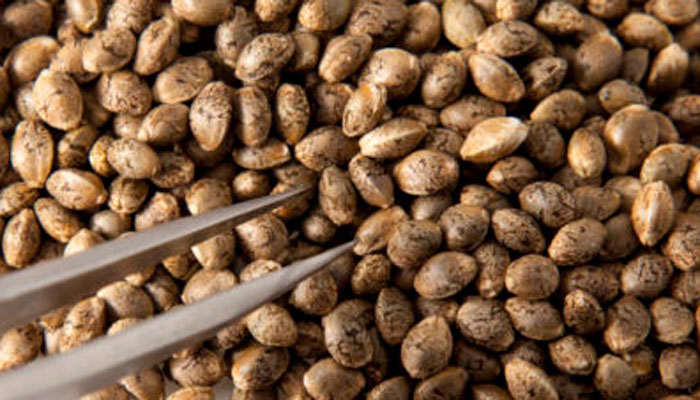
Choose a Waxy Sheen
Good weed seeds have a nice, waxy sheen. The shell quality reveals how the sees will develop.
Your healthy seeds should have a slight shimmer. However, some growers may polish them with wax to make them appear better.
If the seeds are unhealthy, they make them look matte and dull. So, if you can choose between waxy seeds and matte, go for the waxy option.
Consider the Age of the Plant
In nature, cannabis plants grow, produce their seeds, and then disperse the seeds through animal activity. Eventually, some of the seeds pop up from the soil in spring. However, the others simply fertilize the soil.
Growers should consider seeds that are under one year of age when it comes time to begin sowing. This is because fresh seeds tend to germinate rapidly and aren’t as likely to have trouble if they’ve been stored for a little while.
Think About Where the Seeds Originally Came From
If you’re trying to determine if a weed seed is good, think about where the seed originates. Cannabis seed quality varies between reputable seed banks and shoddy bags of bud from your local dealer. So, keep in mind, if you’re looking to grow some nice, potent buds, you should probably check with the seed bank to maximize your chances of growing healthy plants.
Growing seeds indoors usually means you want the best of the best. Thus, your best bet is to check out the professional seed banks. These operations dedicate time, resources, and effort to breed the best cannabis genetics possible.

Germinating Cannabis Seeds for Beginners
Seed germination is the first step in cannabis’s growing cycle. This usually involves using the paper towel method, which uses damp paper towels to germinate the seeds.
High-quality cannabis seeds are important for seed germination and healthy cannabis plants. If you are not ready to germinate your seeds right away, keep them in a cool, dark place without enough moisture to spark germination.
You can either germinate cannabis seeds indoors or outdoors, although we recommend growing them indoors since the higher survival rate of germinating seeds is expected. The wet paper towel is usually the go-to, especially for growers just starting out.
The young seeds will germinate more quickly and successfully when grown indoors because they are not exposed to extreme temperatures or weather conditions, as well as wind, insects, and other animals.
Anyways, here are several methods you can use to germinate successfully:

Method 1: Starter Cubes & Seedling Plugs
The best cannabis germination technique is to utilize specially designed starter cubes and seedling plugs. These plugs make it simple to germinate cannabis seeds.
Simply put a cannabis seed in the cube or plug, fill it with water as directed, and your seeds will be ready for growth.
Each cube or plug includes a hole that is specifically designed for you to plant your seed. Simply push the seed through the pre-cut opening and pinch the top shut with your fingers.
Yes, it’s really that easy!
One such product you can try is General Hydroponics Rapid Rooter Starter Plugs. This is an example of a starter plug.
You can simply put your seeds inside with the pointy side down after presoaking Rapid Rooters in water.
Keep your young seeds in a warm location. Sprouts and roots appear within a few days as sprouts emerge and roots develop.
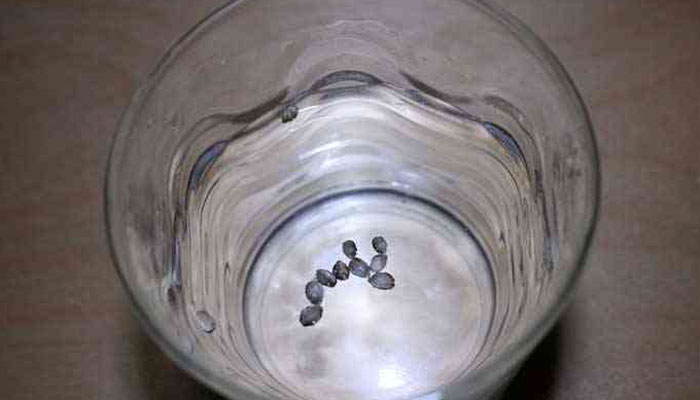
Method 2: Germinate Cannabis Seeds in Water
Another way of germinating seeds is by soaking them overnight in warm water. This method of soaking is particularly effective for extra hard shells or older seeds.
After a few hours of soaking, most viable seeds that started out floating will begin to sink to the bottom of your glass. We recommend using clear glass with clean water in it so you can see the seeds germinate with tiny white taproots emerging from the seeds.
Some take much longer to germinate than others. Older seeds, especially those that have been sitting around for a while, may require more time to break through their shell.
The optimum temperature is 18° C or 65° F. nutrients should not be added. Two or three can be dropped into the water and observed for any changes.
Every other day, you’ll need to dump the excess water and refill the glass with fresh water. Make sure to keep it at room temperature.
After about two to four days, the seeds should begin to split.
You may plant your seeds at any time; but once the roots are 3 to 5 mm (0.1 to 0.2 inches) long, they must be planted.
If you leave the seeds in the water for too long, they can drown.
Germinated seeds are delicate, and the taproots are even more so. If you damage them, your plant may not mature properly.
As you’re planting your sprouted seed in the ground, be cautious and try to place the root facing down if possible.
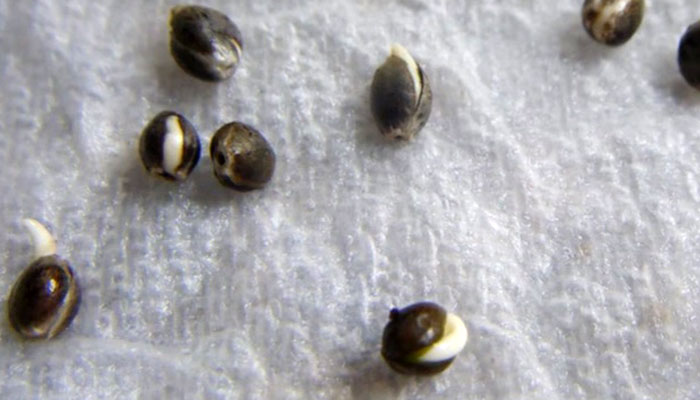
Method 3: Paper Towel Method
Another easy and cheap way to germinate seeds is to use paper towels.
Cheap paper towels usually work better than expensive paper towels because they aren’t as porous.
Commonly used for kitchen cleanups, the nice soft paper towel is too cloth-like that the roots grow into the towel making it hard not to damage the roots when you move the germinated seed.
For this germination method, you will need a couple of plates, paper towels, and a spray bottle with water to moisten the towels.
Place the seeds on a moistened paper towel and fold them over. Then place the paper towel on a plate and cover it with another plate to keep the moisture inside.
Check at least every 12 hours to see if the seeds have sprouted. Re-moisten the paper towel as needed.
Cannabis seeds usually germinate within a few days with this method, although older seeds may take a week or more.
Once you see a taproot growing, you may plant the sprouting seed right away while waiting for other seeds to germinate.
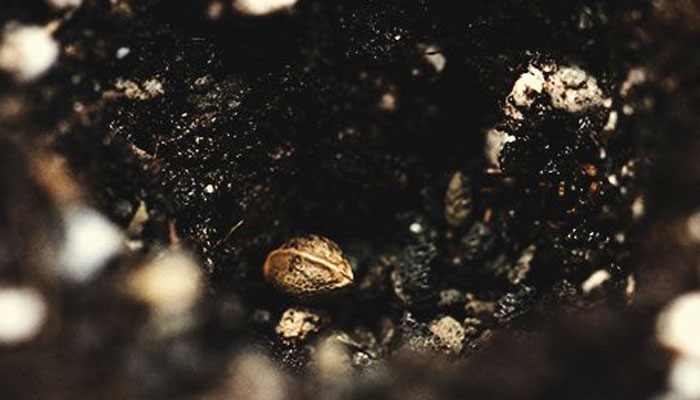
Method 4: Place Cannabis Seed Directly into Soil
Planting directly into your growing soil is the most common and natural way of germinating cannabis seeds. When we plant seeds directly into the soil or other growing medium, germinated cannabis seeds will have minimum interference since there is no need to move the sprouted seed to their most fragile state.
Many growers also use roots stimulators. After 4–10 days you should see a newly emerged young seedling sprout as they begin to form beneath the soil.
It’s possible to now transfer the entire plant and soil to a larger container where normal growth cycles should commence.
Your planting pot will require placing in a damp climatic space within the temperature range specified below our golden rules listed above in order to avoid damage.
The roots will fail to penetrate solid soil slowing the growth. You can still encourage roots to develop.
Use the correct sort of soil when germinating seeds. Lightly fertilized potting soil or a seed-starting mix with a pH of 6 would be ideal.
There is no need to add any more nutrients – potting soil has enough for at least the first two weeks of young plants.
Adding any additional nutrients to the potting soil or growing medium might actually harm your seedlings due to a nutrient overdose.
Place your soil in a small pot. push your finger into it to create a small hole that is up to 1.5cm or half an inch deep. You can also use a pen or pencil to make the holes.
Place one seed into the prepared hole and cover it with soil. After you’ve covered your seed with loose soil, leave it alone.
Water your soil with marijuana seeds using a spray bottle. Place the pots under fluorescent light to keep the temperature stable at 22° Celsius or 72° Fahrenheit.
Note that placing the pots next to a windowsill will not give the stable temperature needed to germinate cannabis seeds.
To keep your soil moist, check it often. Within 4-7 days, seedlings should start to grow from the soil.
Transplant your seedlings into a larger container once they are 2 to 4 inches tall (5 to 10 centimeters). Your young plants will now have multiple roots that will help them grow healthy and strong.
Other Germination Methods
Rockwool
Rockwool is made of volcanic rock and other materials such as basalt and limestone. This material is man-made by melting its ingredients into molten volcanic lava. It is rapidly spun into threads.
Rockwool is commonly used in hydroponic cultivation but isn’t ideal for germinating cannabis seeds. It has to be treated first because the acidity level is too high.
Keep in mind, while it’s a good growing medium, it’s inexpensive and difficult to use, not to mention, not so environmentally friendly.
Jiffy Pellets
Jiffy Pellets are used in a similar way to Rockwool cubes, though these tend to get much better germination results.
Jiffy pellets come in dried pellets, so they can be stored for a long time. Before using them, each pellet must be expanded by soaking it in warm water.
Once the compressed Jiffy pellets have expanded in, carefully squeeze any remaining water from each pellet to prepare them for use. They’re treated the same as Rapid Rooters.
Jiffy pellets are not suitable for most hydroponic setups where the roots are grown directly in water. But Jiffy Pellets can be directly transferred into the soil or the final growing medium.
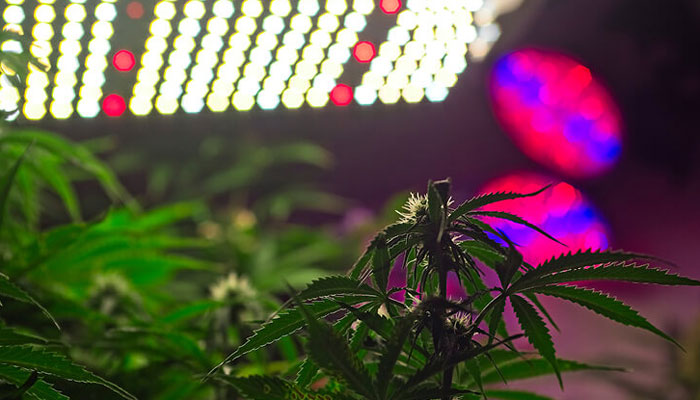
Lighting & Temperature
While you do not need light to germinate seeds, once your seeds sprouted, the seedlings will require light as soon as they emerge from the soil. Young plants are unable to use high-intensity lighting in their first weeks.
For this period, lower wattage lights such as LED and CFL are preferable. A cold (blue) spectrum light is preferable because it encourages vegetative development.
Another factor crucial to seed germination is warmth. Even if cannabis seeds are given access to water, oxygen, and energy, they are meaningless unless they have access to warmth.
Successful germination requires a temperature of 20 to 22 degrees Celsius or 68 to 72 degrees Fahrenheit.
If your place is too cold, you will need artificial lights to provide the warmth to germinate seeds. Adjust the distance between your light source and the viable cannabis seeds to get the right temperature for your sprouting seeds.

Frequently Asked Questions About Germinating Marijuana Seeds
What should I do if the shell is stuck on the seed?
A seed’s shell has become clamped to a newly sprouted plant for every cannabis grower. It’s not a serious problem. But if it’s ignored for too long, it can harm your young seedling.
To remove the shell, apply some lukewarm water to the seed shell using a cotton bud or cotton wool. Be extremely delicate; your seedling is quite sensitive.
Allow 10-15 minutes for the seeds shell to become softer and easier to remove from the seed. Remove the shell with tweezers.
You can re-apply the water if the seed shell is still too difficult to remove.
The hypocotyl (the stem) grows through the earth and seeks light as a newly germinated seed is planted into soil. The outer shell should come off as it pushes up through the dirt, but this isn’t always the case.
The most typical reason for the shell to become stuck is that you didn’t pot your seeds deep enough. If the hypocotyl doesn’t have to work hard through much soil, the shell can get stuck on the seed.
How long do marijuana seeds take to germinate?
The process of germination begins when the first root cracks through the seed’s shell. This can occur anywhere within one to seven days.
The proper temperature and moisture level are essential for germinating seeds. Your cannabis plant seeds should also be kept in a dark location while this germination process takes place.
Not all seeds will sprout even with the best germination method. Around 60% to 90% of seeds usually sprout when germinated correctly.
How to germinate marijuana seeds in water?
If you use paper towels to germinate, mist the paper towels as needed to keep the seeds moist.
If you place the seeds into the soil or other growing medium, you should water the soil or the growing medium before placing the seed or sprout in the holes you created.
Then after filling the holes with loose soil, water by misting the seeds with a spray bottle once or twice daily.
When should I add nutrients?
After your plants have developed 3-4 sets of true leaves, you may give them their first feeding of nutrients. It usually takes around 3-4 weeks for your seedling to utilize all of the energy remaining in the seed.
Around this time, the cotyledons or “seed leaves” may start to yellow. The plant roots start to take the nutrients from the soil or growing medium.
This is a good time to transplant the young plant to a larger container.
The first low-dose feeding will be given after the transplant. This signals the start of the vegetative stage.
When is the seedling ready to be transplanted?
Transplanting seeds at the right time is necessary to prevent the marijuana plants from getting root-bound. If the container is too small, the roots will grow all around it.
Depending on how much the roots have expanded, most cannabis plants may require two transplants.
The first transplant should not be done until the seedling has developed at least four or five sets of leaves. To protect the delicate roots from infection, wash your hands and equipment as well as wear gloves before transferring the plants to a new container in the new pot.
When transplanting, be sure not to harm the roots. Use fresh soil that is mildly fertilized for the new container.
Before moving the plant, make sure you water the soil. Avoid direct sunshine after transplantation since it can induce transplant shock.
Concluding on Cannabis Seed Germination
Cannabis germination can be tricky. Home-growers have taken on the challenge of germination and are eager to share their knowledge with new growers like yourself.
You’ll find that there is a lot of conflicting information out there about how best to germinate your cannabis seeds, which makes it difficult for beginners looking for answers.
We hope this article has helped clear up some confusion by providing easy-to-follow instructions on popular germination methods to germinate your seeds at home. These simple steps will ensure your cannabis seed germinates and grows into a healthy plant!





